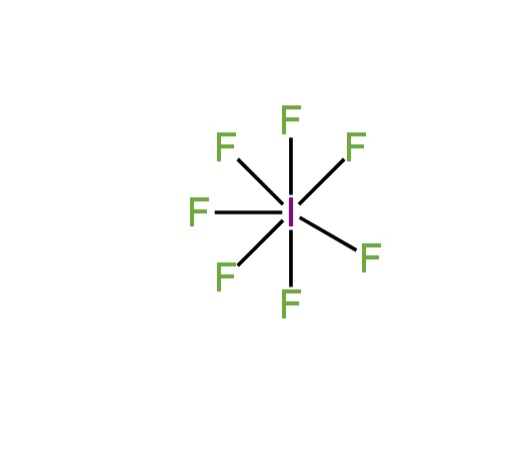
The smallest bond angle is found in
A. \[IF_7\]
B. \[CH_4\]
C. \[BeF_2\]
D. \[BF_3\]
Answer
220.8k+ views
Hint: \[IF_7\] has a pentagonal bipyramidal structure.
\[CH_4\], \[BeF_2\], and \[BF_3\] have tetrahedral, linear, and trigonal planar geometry respectively.
Linear molecules have a bond angle of \[180^o\] which is the highest bond angle.
Complete step by step solution:Here in this question, we have to find out which of the given molecules has the smallest bond angle.
The shape is predicted by VSEPR theory.
A. \[IF_7\]
Here Iodine is the central atom. It is an interhalogen compound.
Iodine has seven valence electrons all of which make a bond with each electron of seven F atoms.
It contains seven bond pairs and zero lone pairs.
So, its structure is pentagonal bipyramidal.
Five bond pairs are in the same plane at an angle of \[72^o\], and the remaining two bond pairs are perpendicular to the plane creating an angle of \[90^o\] with the plane.

Image: Structure of \[IF_7\]
So, A is correct.
B. \[CH_4\]
Here carbon is the central atom.
It has four valence electrons in its valence shell all of which are involved in bond formation.
So, there are four bond pairs.
So, it has a tetrahedral structure.
The bond angle is \[109^o\].
So, B is incorrect.
C. \[BeF_2\]
Here beryllium is the central atom.
It has two valence electrons in its valence shell all of which are involved in bond formation.
So, there are two bond pairs.
So, it has a tetrahedral structure.
The bond angle is \[180^o\].
So, C is incorrect.
D. \[BF_3\]
Here boron is the central atom.
It has three valence electrons in its valence shell all of which are involved in bond formation.
So, there are three bond pairs.
So, it has a trigonal planar structure.
The bond angle is \[120^o\].
So, D is incorrect.
So, \[IF_7\] has a pentagonal pyramidal structure and has the smallest bond angle.
So, option A is correct.
Note: An interhalogen compound is a molecule that includes two or more distinct halogen atoms and no atoms of elements from any other group.
Most interhalogen compounds are binary i.e., composed of two distinct elements.
\[CH_4\], \[BeF_2\], and \[BF_3\] have tetrahedral, linear, and trigonal planar geometry respectively.
Linear molecules have a bond angle of \[180^o\] which is the highest bond angle.
Complete step by step solution:Here in this question, we have to find out which of the given molecules has the smallest bond angle.
The shape is predicted by VSEPR theory.
A. \[IF_7\]
Here Iodine is the central atom. It is an interhalogen compound.
Iodine has seven valence electrons all of which make a bond with each electron of seven F atoms.
It contains seven bond pairs and zero lone pairs.
So, its structure is pentagonal bipyramidal.
Five bond pairs are in the same plane at an angle of \[72^o\], and the remaining two bond pairs are perpendicular to the plane creating an angle of \[90^o\] with the plane.

Image: Structure of \[IF_7\]
So, A is correct.
B. \[CH_4\]
Here carbon is the central atom.
It has four valence electrons in its valence shell all of which are involved in bond formation.
So, there are four bond pairs.
So, it has a tetrahedral structure.
The bond angle is \[109^o\].
So, B is incorrect.
C. \[BeF_2\]
Here beryllium is the central atom.
It has two valence electrons in its valence shell all of which are involved in bond formation.
So, there are two bond pairs.
So, it has a tetrahedral structure.
The bond angle is \[180^o\].
So, C is incorrect.
D. \[BF_3\]
Here boron is the central atom.
It has three valence electrons in its valence shell all of which are involved in bond formation.
So, there are three bond pairs.
So, it has a trigonal planar structure.
The bond angle is \[120^o\].
So, D is incorrect.
So, \[IF_7\] has a pentagonal pyramidal structure and has the smallest bond angle.
So, option A is correct.
Note: An interhalogen compound is a molecule that includes two or more distinct halogen atoms and no atoms of elements from any other group.
Most interhalogen compounds are binary i.e., composed of two distinct elements.
Recently Updated Pages
The hybridization and shape of NH2 ion are a sp2 and class 11 chemistry JEE_Main

What is the pH of 001 M solution of HCl a 1 b 10 c class 11 chemistry JEE_Main

Aromatization of nhexane gives A Benzene B Toluene class 11 chemistry JEE_Main

Show how you will synthesise i 1Phenylethanol from class 11 chemistry JEE_Main

The enolic form of acetone contains a 10sigma bonds class 11 chemistry JEE_Main

Which of the following Compounds does not exhibit tautomerism class 11 chemistry JEE_Main

Trending doubts
JEE Main 2026: Application Form Open, Exam Dates, Syllabus, Eligibility & Question Papers

Derivation of Equation of Trajectory Explained for Students

Hybridisation in Chemistry – Concept, Types & Applications

Understanding the Angle of Deviation in a Prism

How to Convert a Galvanometer into an Ammeter or Voltmeter

JEE Main Marking Scheme 2026- Paper-Wise Marks Distribution and Negative Marking Details

Other Pages
NCERT Solutions For Class 11 Chemistry Chapter 7 Redox Reaction

JEE Advanced Marks vs Ranks 2025: Understanding Category-wise Qualifying Marks and Previous Year Cut-offs

Hydrocarbons Class 11 Chemistry Chapter 9 CBSE Notes - 2025-26

Thermodynamics Class 11 Chemistry Chapter 5 CBSE Notes - 2025-26

NCERT Solutions ForClass 11 Chemistry Chapter Chapter 5 Thermodynamics

Equilibrium Class 11 Chemistry Chapter 6 CBSE Notes - 2025-26




